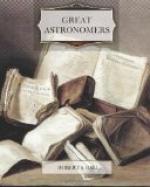In those days it was often the custom for illustrious mathematicians, when they had discovered a solution for some new and striking problem, to publish that problem as a challenge to the world, while withholding their own solution. A famous instance of this is found in what is known as the Brachistochrone problem, which was solved by John Bernouilli. The nature of this problem may be mentioned. It was to find the shape of the curve along which a body would slide down from one point (A) to another point (B) in the shortest time. It might at first be thought that the straight line from A to B, as it is undoubtedly the shortest distance between the points, would also be the path of quickest descent; but this is not so. There is a curved line, down which a bead, let us say, would run on a smooth wire from A to B in a shorter time than the same bead would require to run down the straight wire. Bernouilli’s problem was to find out what that curve must be. Newton solved it correctly; he showed that the curve was a part of what is termed a cycloid—that is to say, a curve like that which is described by a point on the rim of a carriage-wheel as the wheel runs along the ground. Such was Newton’s geometrical insight that he was able to transmit a solution of the problem on the day after he had received it, to the President of the Royal Society.
In 1703 Newton, whose world wide fame was now established, was elected President of the Royal Society. Year after year he was re-elected to this distinguished position, and his tenure, which lasted twenty-five years, only terminated with his life. It was in discharge of his duties as President of the Royal Society that Newton was brought into contact with Prince George of Denmark. In April, 1705, the Queen paid a visit to Cambridge as the guest of Dr. Bentley, the then Master of Trinity, and in a court held at Trinity Lodge on April 15th, 1705, the honour of knighthood was conferred upon the discoverer of gravitation.
Urged by illustrious friends, who sought the promotion of knowledge, Newton gave his attention to the publication of a new edition of the “Principia.” His duties at the Mint, however, added to the supreme duty of carrying on his original investigations, left him but little time for the more ordinary task of the revision. He was accordingly induced to associate with himself for this purpose a distinguished young mathematician, Roger Coates, a Fellow of Trinity College, Cambridge, who had recently been appointed Plumian Professor of Astronomy. On July 27th, 1713, Newton, by this time a favourite at Court, waited on the Queen, and presented her with a copy of the new edition of the “Principia.”




